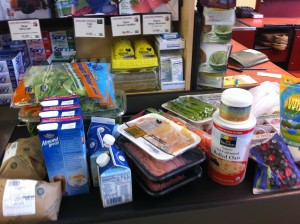Many believe that if they eat healthfully, they will lose fat. And almost anyone you ask claims they eat healthy. Yet over two-thirds of the US population is overweight or obese, so there is an obvious discrepancy here? The easy explanation for this is that most people overestimate the healthfulness of their diet, which is usually true. However, the more important distinction is that “healthy” eating and fat loss eating is not the same thing. And if you are eating healthy, you are not necessarily going to be burning fat. Metabolic Effect explains “A healthy diet is not always a fat loss diet, but a fat loss diet is almost always a healthy diet”–such a key distinction when learning to eat for real fat loss.
For example, there are several foods and food groups that are healthy—meaning they contain high amounts of vitamins and minerals as well as healthy fiber or good fats—but will do very little to help burn fat. In fact, some of these healthy foods may even stall fat loss for susceptible individuals or if eaten to excess. Fat loss foods, however, are both healthy and fat-loss friendly. For a food to be considered great for fat loss, there are a couple of key items to examine.
Fat loss characteristics
First, the food should be relatively low in calories (and therefore also lower in fat since 1g of fat contains 9 calories, which can add up quickly). This is the major reason why nuts in general are not considered great fat-loss foods, though healthy. The fat content in foods like nuts, avocado, olives, cheese and coconut is simply too much to aid fat loss, though these are all certainly healthy foods that contribute valuable vitamins, minerals, healthy fats and fiber.
Second, it should have more protein and/or fiber relative to sugar (or carbohydrate). Foods containing higher protein slow the absorption of carbohydrate, preventing major dips in energy while also keeping you fuller for longer. Protein also requires more calorie use during the digestion and absorption process (a higher thermic effect).
Foods with a higher fiber content relative to total carbohydrate are key for fat loss also. These are mainly lower glycemic index fruits, all fibrous vegetables and leafy greens. Whole grains have higher absolute amounts of fiber but contain too much total carbohydrate (relative to fiber) to be considered a true fat loss food. Fiber also helps to stabilize blood sugar, decreasing hunger and cravings. Metabolic Effect does a great job of explaining the importance of this.
Finally, fat loss foods are ones that are higher in water relative to sugar. For example, fruits in general have a very high water content, but many contain high amounts of natural sugar. Choose fruits that are lower on the glycemic index, contain higher amounts of fiber as well as water. All fibrous veggies too contain a greater percentage of water than do denser, starchy veggies like potatoes, peas, corn and squash, and thus are great for fat loss.
Here are my top 15 foods that are great for fat loss, but also help optimize health:
Egg whites: High in protein and low in sugar, an 8-egg white omelet has only 240 calories and will keep most full for hours.
Bison or grass-fed beef: Containing less saturated fat than its conventionally raised counterparts, lean cuts of grass-fed beef and bison have a nutrition profile similar to that of fish.
Chicken breasts: Lean protein with very little fat, chicken breasts are the cornerstone of any effective fat loss nutrition plan.
Lean turkey (ground or breasts): Similar to that of chicken, get lean turkey in a 93% or 99% variety.
White fish (halibut, cod, tuna, etc): Some of the leanest protein sources around, fish provide a good volume of food for relatively few calories.
Shrimp: Shrimp (along with other shellfish) contain high amounts of the amino acid taurine, supplementation of which has been implicated in research to potentially facilitate weight loss in obese people.
Pea or rice protein powder: Because of their hypoallergenic properties, these protein powder varieties are preferred for fat loss over dairy-based whey and casein, yet contain the same low sugar content. Likewise, these varieties contain less sodium than egg white powder.
Spinach & all other leafy greens: Some of the most obvious fat-burning foods, packing fiber and water with very little carbohydrate. Containing B-vitamins, important for energy metabolism.
Asparagus: A natural diuretic, this fat-loss staple offers quality fiber with little sugar.
Broccoli: Part of the cruciferous family of vegetables along with cauliflower, brussel sprouts, cabbage, bok choy and others, this family of veggies helps to detoxify estogen in the liver, creating a more favorable estrogen to progesterone ratio, conducive to fat loss.
Oat bran: Mostly gluten-free oat bran contains higher fiber and higher protein than its oatmeal counterpart.
Sweet potato: Chock full of important minerals, sweet potatoes are hypoallergenic and have a lower glycemic index than white potatoes.
Berries: Choosing lower glycemic index fruits like berries are important for obtaining vitamins, minerals and fiber without the fast-acting carbohydrate.
Grapefruit: This fat-loss fruit contains over 90% of water by volume, less than 100 calories, with a low glycemic index score. Its naringin flavonoid displays antioxidant properties and may increase the half-life of caffeine.
Apple: An apple a day keeps the inches at bay. Full of satiating fiber, apples are a great fat loss food when paired with protein from nuts or nut butters. Remember to always add a protein source when eating fruit.
Unsweetened cocoa powder: This extra-low calorie treat is all fiber with zero impact carbohydrate. It contains important alkaline minerals like magnesium, and is involved in the dopamine production process, boosting motivation and mood.

